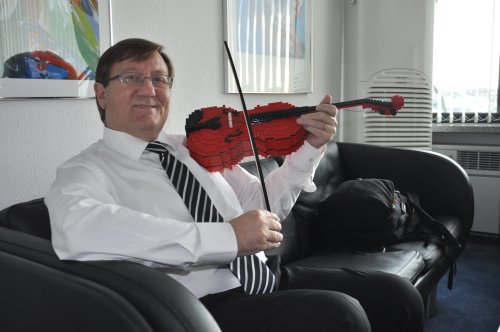Throughout the world’s history, many great leaders have led by example; in the fight against climate change some countries are doing just that.
Denmark is a country which has changed not only the way its people use energy but has also looked for synergies to expand their green tech industries and philosophy for a greener, more energy efficient tomorrow.
Many diplomats say that what started off in Copenhagen during the climate conference in 2009 is just the beginning of a long road toward weaning countries off the need to power their industries and society with fossil fuels.
In South Korea, the Danish ambassador has taken one small step forward for the betterment of his mission and as an example for society at large.
“We have just made this a green embassy. This means we are committing ourselves to reducing our energy consumption by 10 percent in the next three years just by switching off the lights and turning off the computers when we go home at night,” said Danish Ambassador Peter Lysholt Hansen to The Korea Herald.
In the last 30 years, Denmark’s economy has grown 70 percent without increasing the consumption of fossil fuels.
“Energy efficiency has enormous potential,” he said. “We have to realize that each one of us has a responsibility to save energy in order to achieve such results.”
 |
Danish Ambassador Peter Lysholt Hansen playsa violin made from Lego parts which could beused for the educational development of youngchildren. (Yoav Cerralbo/The Korea Herald) |
Compared to November 2009, the embassy accomplished savings of 30.7 percent. In December, the embassy further saved a massive 42.3 percent compared to the same month in 2009.
In the next two years, the embassy will initiate other green initiatives such as energy efficient procurements and energy efficient running and maintenance of the chancery.
Hansen has for many years been a strong advocate for Denmark’s international efforts in environment, energy and climate, and was the key driving force behind one of the first Danish missions that signed a Curve Breaker Agreement with the Danish Energy Savings Trust.
In Korea, Hansen sees tremendous potential for companies, governments and universities in both countries to collaborate in the green technology sector.
“One area for me, which should have big potential, is increasing energy efficiency in housing,” he said.
“This is part of the success we have had in decoupling economic growth and use of energy and it has a lot of potential,” Hansen said with optimism.
Denmark is also a leader in the production of windmills and other kinds of green technologies.
As for its designs and creations, Denmark is one of those global leaders that the world looks to for inspiration.
Danish architects are designing more energy efficient buildings; something that Hansen believes both countries could work together on implementing and exporting.
Urban planning is also something the ambassador feels could be a driving force for both countries.
This does not mean buildings have to be torn down; instead, Hansen explained that more green areas and special roads for bicycles could be created which will, in turn, enhance the lives of the nation’s citizens.
About 40 percent of the population of the Danish capital, Copenhagen, uses bicycles to travel to work.
“I’m not saying that Korea should do this but I believe there are a lot of possibilities and it’s good for your health and it’s good for the environment,” he said.
But the change from cars to bicycles did not happen overnight in Copenhagen.
“First of all, people should see the interest for biking as a health issue. Then it’s a question of government. The Copenhagen municipality is providing incentives by creating designated biking lanes where people can travel from one part of the city to the other in relative safety,” he said.
Some might argue that Seoul is on its way by offering bike lanes along the Han River but the problem remains that people still need to pack up their bicycles in a car to ride along the Han.
Hansen added that it is the same with energy efficient homes: “If there are no incentives or penalty, it will not happen.”
Denmark and Korea have a lot in common. Both countries are indebted to other countries for their energy needs and both countries have many old homes that emit valuable energy faster than the recent hike in the price of gas.
In Denmark that question was answered in the way of tax incentives.
“If the government gives a tax deduction of 20-30 percent of the cost of putting in energy efficient windows, then there is a real incentive and it can earn itself very quickly,” Hansen noted.
Denmark also consistently ranks as one of the world’s happiest countries.
According to researchers at the Gallup World Poll, after surveying thousands of respondents in 155 countries, between 2005 and 2009, Denmark ranked as the happiest country while Korea ranked 56.
Hansen believes that it is a question of balancing one’s work and private lives by prioritizing what is important both at work and at home.
“This is something that will become more and more important for Koreans as soon as they reach the same level of development and per capita income as Denmark,” he said. “So I think that is another possibility for collaboration.”
By Yoav Cerralbo (
yoav@heraldcorp.com)





![[Herald Interview] 'Korea, don't repeat Hong Kong's mistakes on foreign caregivers'](http://res.heraldm.com/phpwas/restmb_idxmake.php?idx=644&simg=/content/image/2024/11/13/20241113050481_0.jpg)
![[KH Explains] Why Yoon golfing is so controversial](http://res.heraldm.com/phpwas/restmb_idxmake.php?idx=644&simg=/content/image/2024/11/13/20241113050608_0.jpg)

